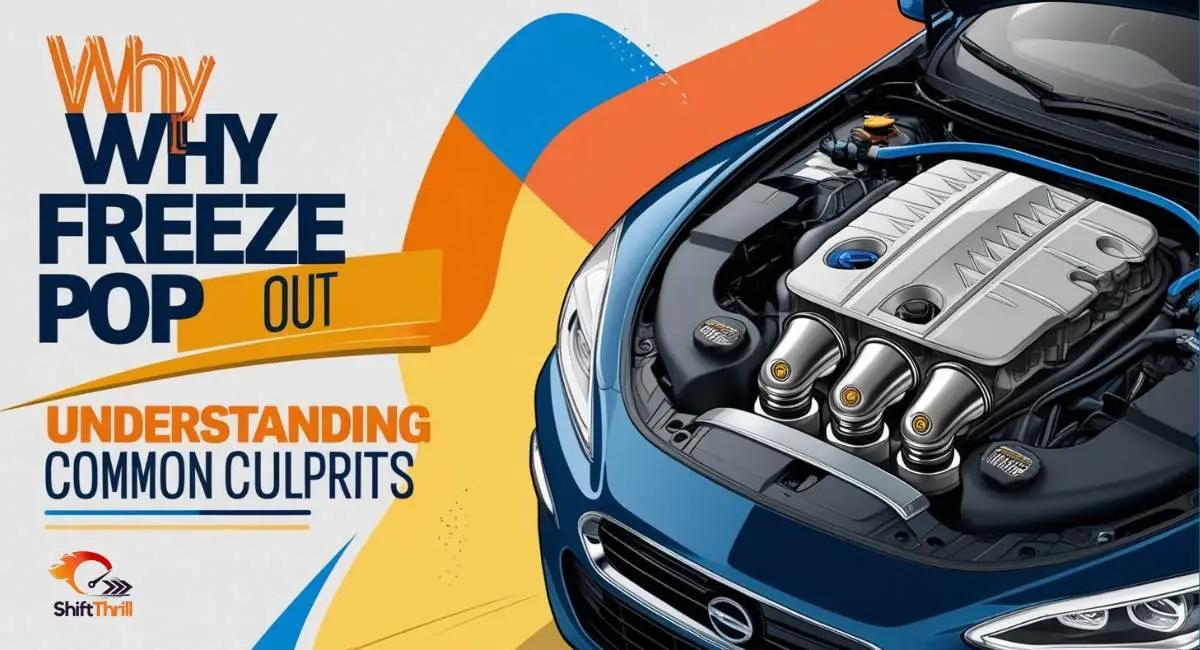Freeze plugs, also called core plugs or expansion plugs, are tiny yet vital components of your vehicle’s engine. They protect your engine from damage caused by freezing conditions while also sealing it during manufacturing. However, when freeze plugs pop out, they can lead to coolant leaks, engine overheating, and costly repairs if not addressed promptly.
In this comprehensive guide, we’ll delve into what freeze plugs are, why they pop out, and how you can prevent and fix such issues to keep your engine running smoothly.

What Are Freeze Plugs and Why Are They Important?
Freeze plugs are small, round discs or caps made of brass, steel, or rubber that seal casting holes in the engine block. These holes are created during the engine manufacturing process to allow for proper cooling and mold removal.
While the main purpose of freeze plugs is to seal the engine block, they also act as a safeguard. If the coolant in your engine freezes during extremely low temperatures, it expands significantly. This expansion can create immense pressure inside the engine block, potentially causing it to crack. Freeze plugs are designed to pop out under high pressure, relieving the strain and saving your engine from severe damage.
Did You Know? Water expands by approximately 9% when it freezes. This may not sound like much, but in a confined engine block, this expansion creates enough pressure to damage even the toughest metals.
Why Do Freeze Plugs Pop Out?
Freeze plugs can pop out for several reasons. Let’s take a closer look at the most common culprits:
1. Freezing Temperatures
If you live in a region where temperatures drop below freezing, this is a primary cause to consider. When your coolant lacks the proper antifreeze-to-water ratio (usually 50:50), the water content in the coolant can freeze. As the frozen water expands, it creates pressure that can force the freeze plugs to pop out.
Example Scenario: Imagine parking your car outside during a snowstorm without enough antifreeze in the cooling system. As the water in the system freezes overnight, the expanding ice pushes out the freeze plug, leaving your car with a leaking coolant system by morning.
2. Corrosion and Rust
Coolant that hasn’t been changed or maintained regularly can become acidic over time. This acidity corrodes metal freeze plugs, making them weaker and more prone to failure. Additionally, rust can accumulate around the freeze plug, further compromising its integrity.
Key Statistic: Studies show that up to 40% of freeze plug failures are linked to corrosion caused by neglected coolant maintenance.
3. Poor Installation
Improperly installed freeze plugs—whether too tight, too loose, or misaligned—can lead to premature failure. If a plug is not seated flush with the engine block, vibrations and pressure changes can cause it to loosen and pop out.
4. Excessive Heat and Thermal Cycling
Engines heat up and cool down during operation, which causes the metal in freeze plugs to expand and contract repeatedly. Over time, this thermal cycling can weaken the plug’s grip on the engine block, increasing the likelihood of it popping out.
5. Age and Wear
Like any other car component, freeze plugs deteriorate with time. Metal plugs may corrode or thin out, while rubber plugs can harden, crack, or lose elasticity. This natural wear and tear can lead to failures, especially in older vehicles.
Signs That a Freeze Plug Has Popped Out
Freeze plug issues are often accompanied by telltale signs. Here’s what to look for:
1. Coolant Leaks
- One of the most common symptoms. Check for coolant puddles beneath your car or around the engine bay.
2. Engine Overheating
- A missing freeze plug disrupts the cooling system, causing the engine to overheat.
3. Visible Freeze Plug Movement
- Inspect your engine block for any loose or missing freeze plugs.
4. Unusual Noises
- Whistling or gurgling sounds may indicate coolant escaping through a dislodged plug.
5. Dashboard Alerts
- Keep an eye on warning lights, such as “low coolant” or “high engine temperature.”
How to Prevent Freeze Plug Failures
Preventing freeze plug problems is much easier and less expensive than repairing them. Here are some effective tips:
1. Maintain Proper Coolant Levels
- Use a 50:50 antifreeze-to-water mixture to prevent freezing and corrosion.
- Flush and replace your coolant every 2–5 years, depending on your vehicle’s maintenance schedule.
2. Protect Your Vehicle in Cold Weather
- Use an engine block heater if you live in areas with harsh winters.
- Park your car in a garage or use a car cover to minimize exposure to freezing temperatures.
3. Inspect Freeze Plugs Regularly
- Check for signs of rust, wear, or improper installation during routine maintenance. Replace worn-out plugs promptly.
4. Prevent Overheating
- Ensure your cooling system components (radiator, thermostat, hoses) are in good condition. Overheating weakens freeze plugs and increases the risk of failure.
5. Choose High-Quality Freeze Plugs
- Opt for corrosion-resistant materials like brass or stainless steel when replacing freeze plugs. They last longer and are less prone to rust.
How to Fix a Popped Freeze Plug
If a freeze plug has popped out, here’s what you can do to fix it:
Step 1: Locate the Problem
- Identify which freeze plug is missing. This may require removing other components to gain access.
Step 2: Replace the Freeze Plug
DIY Fix:
- Drain the coolant from the system.
- Remove the damaged or dislodged plug.
- Clean the area thoroughly to ensure a tight fit for the replacement plug.
- Install the new plug using an installation tool or driver. Apply a sealant if recommended.
Professional Assistance:
- If the freeze plug is in a hard-to-reach spot, consult a mechanic.
Step 3: Test the Repair
• Refill the cooling system with fresh coolant and check for leaks. Start the engine and monitor its performance to ensure the issue is resolved.
Temporary Fixes for Emergencies
If you can’t replace a freeze plug immediately, there are temporary solutions to buy you some time:
Rubber Expansion Plugs
- These can be installed quickly and provide a temporary seal.
Coolant Stop-Leak Products
- These products can temporarily seal small leaks in the cooling system but may cause clogging if overused.
Important Note: Temporary fixes are not a long-term solution. Replace the freeze plug properly as soon as possible.
Costs of Freeze Plug Replacement
The cost of fixing a freeze plug issue depends on factors like the location of the plug and whether you’re doing it yourself or hiring a mechanic:
- Parts: Metal freeze plugs cost $5–$20 each.
- Labor: Professional replacement can cost $200–$600, especially for hard-to-reach plugs.
- DIY Repairs: If you’re comfortable with tools, you can save on labor costs.
FAQs About Freeze Plugs
Q: Can I drive without a freeze plug?
- No. Driving without a freeze plug can result in severe coolant loss, engine overheating, and permanent damage.
Q: How often should I replace freeze plugs?
- Freeze plugs generally last the lifetime of the engine but should be inspected during coolant flushes.
Q: What’s the best material for freeze plugs?
- Brass and stainless steel are highly durable and resistant to corrosion, making them the best choice for replacements.
Conclusion
Freeze plugs may seem like small and insignificant parts, but their role in safeguarding your engine is critical. Understanding why they pop out, recognizing the warning signs, and knowing how to prevent and fix freeze plug issues can save you from costly repairs and engine damage.
Whether it’s maintaining the right coolant levels, protecting your car from freezing temperatures, or choosing high-quality freeze plugs, proactive care is key to keeping your vehicle running safely and efficiently.
By following the steps and tips outlined in this guide, you can avoid the headaches associated with freeze plug failures and ensure your engine remains in top condition.
